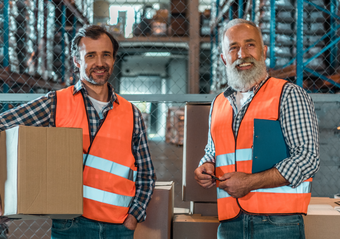However, using Optima WMS has several objectives. The existing situation and procedures, the type of warehouse and the products stored determine how big the profit will be in the various areas.
Although in specific situations additional objectives may be formulated, the focus for Optima WMS is mainly on realizing the following goals.
Goods are temporarily stored in the warehouse. To do this as efficiently as possible, Optima WMS will focus on two things:
Maximum use of the available space
When choosing a free storage location for a carrier, the system takes into account the type of carrier and the stacking height of that carrier. By coordinating location and carrier, less air is stored.
By using the free location system, no locations are kept free for goods that are not in stock. This form of storage is more compact than storage in a fixed location system, where a location is reserved for each type of item, even if the item is not in stock.
Minimizing distances
An important part of the resources available in the warehouse is spent on moving goods from source to destination. It is therefore very important to make the total distance to be covered as short as possible. By stocking popular items closer to shipment, the walking or driving distance to those items is reduced. Since these articles are frequently requested, this limits the total distance to be covered. By assigning a rotation characteristic to both articles and locations, Optima WMS will automatically take this into account. In addition, this can be dynamically adjusted.
Often items from the same item group are needed at the same time.
Optima WMS allows you to store the articles per article group. Zones are created, consisting of a group of locations. Articles that belong to the same article group are automatically stored in each other's vicinity.

Optima WMS is a real-time system and the assignment and execution of tasks is continuously evaluated. For example, the system calculates optimal walking and driving routes. Requested priorities are taken into account in the order of execution. Running empty is avoided. All of this is aimed at doing as much work as possible in as little time as possible.
Optimizing and synchronizing tasks is done automatically. This does not require communication between the employees. This prevents stress in the workplace.
Incorrect deliveries cause reverse logistics. This is expensive and can adversely affect the relationship with the customer. But internal errors can also lead to an incorrect estimate of the stock, which in turn has an impact on the sales process.
Errors in the handling of goods must be avoided. Optima WMS supports several control systems:
If desired, we also supply and install all associated equipment that is required for the realization: mobile terminals, printers, components...
Sales and purchases based on an incorrect stock lead to annoying situations. It is therefore crucial that the sales system has the correct information.
Optima WMS registers every increase or decrease of product at a location. The current stock of an item is the sum of all available stock at the various locations where that item is located. The stock is therefore, as it were, 'measured'.
When a deviation is detected at a location (eg due to a counting error), this is immediately corrected in the system thanks to the real-time connection.
Optima WMS analyzes the received customer orders and orders from suppliers and translates them into tasks to be performed. In most cases, a job involves moving goods from a source location to a destination location.
The tasks to be performed can be divided into sub-tasks (eg when working with intermediate locations or when a means of transport has to be changed). In this way, a pool of tasks to be performed is created.
Depending on the available operators and tools, Optima WMS will assign the execution of a task to an operator. This involves looking at what rights the operator has (what kind of tasks he is allowed to perform), what tool the operator uses (not every task can be performed by every tool), in which zone the tool may be used and which tasks have priority and therefore must be performed first.
An order can be converted into multiple tasks that are (simultaneously) completed by different operators. Conversely, several orders can also be taken together in one picking round and processed by one operator (eg batch picking). The order in which the tasks are performed is also logically determined so that minimal movements are required.
The operator does not have to take the initiative himself, he is automatically offered the task to be performed. Optima WMS acts as a conductor here: it distributes the tasks and monitors their correct execution. When the job is finished and there are still jobs available, the operator is offered a new job.

Various functions are integrated as standard in Optima WMS to measure the quality of incoming and outgoing goods and deliveries. Deviations identified can be documented and subsequently traced. Some examples are:
Reception of goods:
checking correctness of delivered products and numbers
recording and/or checking product characteristics
check for damage, registration of comments
Optima WMS records the details of every movement:
Start and end time of the task execution
Operator who performed the job
Affected carrier
Affected article
Source location of the movement
Destination location of the movement
In this way, the history of the movements of each carrier can be reconstructed in the event of a calamity. In addition, the efficiency per operator, item, carrier... can be evaluated by bringing the movements together in a report.
Learning time for an operator to work with Optima WMS is extremely low. The applications are intuitive to use. It is sufficient that the operator knows the basic layout of the locations in the warehouse in order to use the system.
The screens or messages are constructed in such a way that they are self-explanatory. Assignments are always provided with additional information.
In this way, temporary employees can be used smoothly in the event of a seasonal peak or when replacement personnel are used.
The idea behind this is that the software supports the physical job to be performed. The process in the application is divided into steps that are also physically executed. Only the next step is shown during the execution. The application therefore runs parallel to the action to be performed.
PROCESS DIAGRAM
The diagram below shows how Optima WMS works: orders are received via the import module, where they are converted into tasks to be executed via warehouse orders. Available operators and machines are assigned the tasks to perform them. The results of the execution are fed back to the host via the export module.
If you would like to know more about what Optima WMS can mean in your specific case, we will be happy to visit you to look at the possibilities together.
Based on a visit to your current warehouse and the existing operation, together with the discussion of any bottlenecks and specific wishes, we are able to form an initial picture of how an implementation would work, free of charge, what can be expected and what target budget should be provided for this.
You can give us some more details via the contact form, of course this can also be done by telephone on +32.16.300.960 or by e-mail at info@dastronic.be
Copyright © All rights reserved